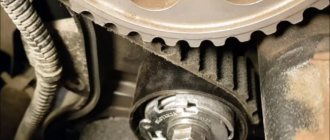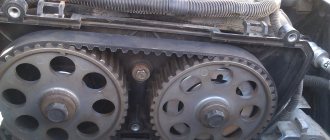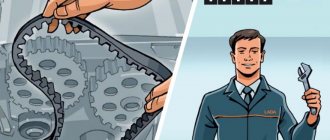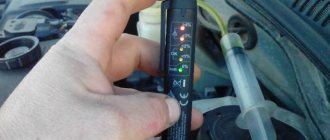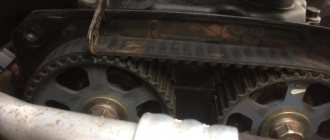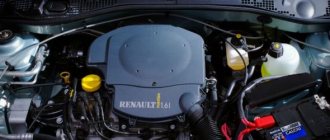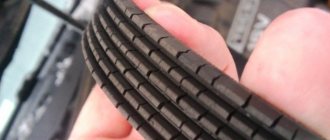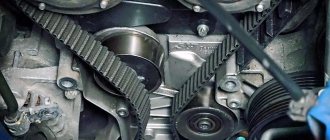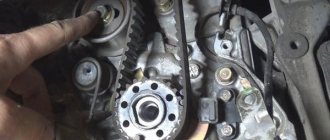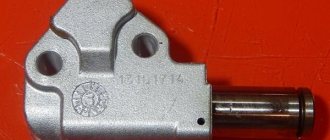September 16, 2020 Lada.Online 113 788 24
Why do LADA owners care about the frequency of replacing the timing belt (gas distribution mechanism) on their cars? Mainly due to the consequences of a broken belt, in some cases the valve bends, which ends in expensive repairs. Let's figure out at what mileage the manufacturer recommends changing the timing belt and rollers, as well as what its actual service life is.
Part numbers
Since the engines installed in the piston bottom do not have grooves for the valves to prevent them from bending when the belt breaks, there is no need to save on this consumable. It is preferable to install an original belt or a replacement from Contitech and Gates.
Original
In the spare parts catalog of JSC AvtoVAZ, the required spare parts are indicated by the following numbers:
- 2108-01006040-82 for engine 11189;
- 8201069699 for engines 21129 and 21179.
The minimum price on exist.ru is 360 and 2500 rubles, respectively.
Substitutes
| Manufacturer | vendor code | Minimum price on exist.ru, rub. |
| For 2108-01006040-82 | ||
| Bosch | 1 987 949 095 | 340 |
| Contitech | CT-527 | 330 |
| Dayco | 94738 | 410 |
| For 8201069699 | ||
| Contitech | CT-1179 | 1050 |
| Dayco | 94847 | 930 |
| Gates | 5671 XS | 1800 |
| Npa | NP511-01622 | 450 |
| Renault | 8201069699 | 1700 |
AVTOVAZ recommendations
It is immediately worth noting that on the official LADA website in the maintenance calculator (it is only up to 90 thousand km) nothing is said about replacing the timing belt and rollers. However, information about this is in the service book of some LADA models.
Lada Priora:
No information available.
Lada Granta, Kalina:
- The 2015 service book indicated that for the 8-valve engine, replacement is provided at a mileage of 75,000 km.
- The 2022 service book states that the timing belt, tensioner and support roller (if equipped) should be replaced at a mileage of 180 thousand km.
- From June 2022, the timing belt must be replaced at 90,000 km.
Lada Largus:
- Engine Renault K4M (1.6 16V). The timing belt and rollers should be replaced at 120 thousand km or 6 years.
- Engine VAZ 11189 (1.6 8V). The timing belt and rollers should be replaced at 160 thousand km or 8 years. It is noteworthy that the Lada Vesta service book (until 2022) indicated that on the VAZ-11189 engine, replacement is provided at a mileage of 180,000 km (until 06.2021) or 90,000 km (from 06.2021).
Lada Vesta, XRAY
:
- Engine VAZ-21129 (1.6l., 16kl.). The timing belt along with the rollers should be replaced at a mileage of 180,000 km (until 06/2021) or 90,000 km (from 06/2021).
- Engine VAZ-21179 (1.8l., 16kl.). The timing belt along with the rollers should be replaced at a mileage of 180,000 km (until 06/2021) or 90,000 km (from 06/2021).
Conclusion
:
- AVTOVAZ periodically changes the regulations for replacing timing belts and rollers.
- From June 2022, according to the regulations, the timing belt must be replaced at a mileage of 90,000 km.
Replacing the timing belt on Vesta with engine 11189 (1.6 liters, 8 valves)
The procedure is as follows:
- Place the car on the inspection hole and raise the parking brake lever. Loosen the nuts on the right front wheel.
- Remove the decorative engine cover.
- Raise the car on a jack, install a stand and remove the jack.
- Remove the wheel.
- Remove the gas distribution mechanism cover by unscrewing 3 bolts with a 10mm head.
- Loosen the bolt securing the generator to the bracket on the cylinder block, move it towards the block and remove the generator belt.
- Align the marks on the camshaft pulley and the cylinder head by rotating the crankshaft clockwise with the head “17”. To make rotation easier, it is recommended to unscrew the spark plugs.
- Lock the crankshaft by inserting a screwdriver into the flywheel teeth through the starter hole. To remove the starter, you need to disconnect the power wire by unscrewing the nut with a “13” head and unscrew the 3 mounting bolts with a Torx E10 head.
- Unscrew the bolt from the crankshaft using a 17mm socket with an extension from a hollow tube and remove the generator pulley and the washer underneath it.
- Loosen the nut securing the tension roller by half a turn with the socket “15”.
- Remove the belt.
- Install the new part by sliding the left leg onto the water pump pulley and roller, and then onto the camshaft pulley.
- Insert pliers into the grooves on the tension roller and turn it until the 2 rectangular marks coincide and tighten the nut with the head “15”.
- Check for correct installation by turning the crankshaft 2 turns. If the marks on the pulleys and the engine do not match, reinstall the belt. Otherwise, install all the removed parts back.
Analogue belt brands
If we talk about the best brands, then Gates, Contitech, Dayco and Bosch are the most promising in the segment and enjoy decent popularity.
Drivers trust spare parts from the Belgian company Gates, whose manufacturers supply their products to car factories.
An analogue of Geitz is the German company Contitech; its parts are also used during vehicle assembly.
When choosing timing belts, you should choose the original, which may be more expensive in price, but will last a long time. We wish you that your timing belt never breaks and is serviced on time!
Replacing the timing belt on Vesta with engine 21129 (1.6 liters, 16 valves)
- The procedure is as follows:
- Follow steps No. 1-4 from the previous method.
- Remove the right engine mount:
- Remove the engine splash guard (protection) by unscrewing 13 bolts with a 10mm head.
- Place a jack under the oil pan and lift the engine.
- Using a 16mm head, unscrew the 2 bolts securing the support to the body.
- Lower the right side of the engine until the support is below the lower edge of the side member.
- Unscrew the 2 bolts securing the support to the engine using a Torx E12 head and remove it.
- Unscrew the 5 bolts from the upper cover of the gas distribution mechanism with a hexagon and remove it.
- Unscrew 10 screws using a T20 Torx bit and use a screwdriver to pull out the fasteners securing the right fender liner to the body and remove it.
- Remove the accessory belt:
- Use a slotted screwdriver to pry up the plug on the tension roller.
- Using a 13mm head, loosen the nut on the roller
- Insert the T55 bit into the groove on the roller. Turn the part clockwise, loosening the tension, and remove the belt.
- Turn the crankshaft with the head “17” until the marks on the camshaft pulleys (convex points) coincide with the marks on the cylinder head cover (triangular slots in the plate).
- Follow step No. 8, 9 from the previous method
- Unscrew the 3 screws using a hexagon that secure the lower timing case cover to the cylinder block.
- Follow steps No. 10, 11 from the previous method.
- Place the right branch of the new part on the crankshaft pulley, the intake camshaft (right), and the exhaust camshaft (left), one by one.
- While holding the right arm taut, place the belt over the water pump pulley and tensioner pulley.
- Follow steps No. 13 and 14 from the previous method.
Why does the break occur?
A broken timing belt or chain occurs for a number of reasons:
- defective or counterfeit belt/chain;
- poor maintenance, failure to meet replacement deadlines;
- Damage to the belt, chain or entire timing mechanism.
This can be avoided by timely servicing of the car at a dealer service station or in a proven service club (there is a risk of losing the warranty). A cheaper option would be to do it yourself.
Four Well-Known Facts
The service life of the timing chain always exceeds the service life of the engine. This is the first fact, but a condition must be met: the oil change must be timely. In general, the circuit fails gradually, and this is accompanied by symptoms:
- Audible sounds (chirping) at idle speed;
- When the “problem area” passes, a phase shift may be observed.
The last defect is detected using computer diagnostics.
From the appearance of any symptom to the complete rupture of the chain, a certain time passes. And in general, a “defective circuit” can work for a long time. This was another, fourth fact.
Inspection
The mechanism must be inspected every 20,000 km. During the inspection, it is necessary to pay special attention to contamination of the mechanism (dust, dirt, oil, antifreeze). If debris is found under the belt cover, it is necessary to remove all dirt, and if there are traces of oil or antifreeze on the belt, it is recommended to replace it soon.
The belt should be free of cracks, chips and tears, and there should be no threads sticking out of it.
The rollers should not make noise or creaks, the plastic on them should be smooth without cracks.
The water pump (pump) should not have any play or leakage of coolant.
Powertrain options
The car was initially equipped with three different power units: two engines with a displacement of 1.6 liters and one 1.8 liter. The AvtoVAZ plant designed the so-called 27th and 29th engines, or their full markings - 21127 and 21129. The first one had to be abandoned over time. The VAZ-21127 engine had a long service life and good technical characteristics, but its non-compliance with Euro-4 standards forced AvtoVAZ engineers to look for a way out of this situation. The solution was found in the following - to bring environmental performance indicators to perfection by modernizing the engine.
The difference between these two power units is as follows:
- The compression ratio was reduced from 11.0 to 10.45 in the 29th engine;
- The control unit controller received new firmware with a completely different algorithm;
- The exhaust and resonance starting system has undergone modernization;
- The parts of the connecting rod and piston group have been lightened.
The new engine has joined the ranks of 16-valve engines. In general, the manufacturer managed to technically improve the Lada Vesta engine without changing the displacement or loss of power. You can also find a modification with a Nissan HR16 DE power unit under the hood. It was designed with the help of foreign engineers. The Nissan engine works effortlessly on both the AI-92 and AI-95. At the same time, the internal combustion engine was equipped with a chain instead of a timing belt, which allowed it to outperform its counterpart somewhat in terms of actual service life.
“Resource” Lada Vesta and Lada XRAY: we answer readers’ questions. Part three
In our special section dedicated to resource tests of Vesta and Xray, Autoreview readers leave their questions about two new AvtoVAZ products. We continue to answer some of them.
Tell me, please, does your Xray also accumulate water in the doors after rain or washing? This is a problem in my car.
AR: No, we haven’t seen anything like that. There are only comments about the door seals: the thresholds are wet and dirty in wet weather, and dusty in dry weather.
I would like to know about Vesta’s air conditioner: how it behaves, whether it cools enough in the heat of +30 degrees, whether it stalls the engine in urban conditions and on the highway.
AR: Cools enough. For example, in the heat of over +30 degrees, the car stood for more than half an hour in the sun (the outside temperature sensor showed +51 degrees!), and the air conditioning system did an excellent job.
Bukreev Oleg Sergeevich
I am the owner of a Lada Vesta car. When you start the car in the morning and start driving at low speed, you hear a distinct crackling sound lasting about two seconds. I tried for a long time to find the source and found out that this sound was produced by the ABS system (when I pulled out the fuse and started driving without it, there was no noise, as soon as I inserted it and drove it, it appeared). Tell me, is there such a sound on “resource” cars?
AR: This is not observed on any of our “resource” Ladas.
Does Xray have engine detonation when shifting gears? How does air conditioning work at low speeds (in traffic jams)? Does the car occasionally jerk when starting from a stop?
AR: We have no questions about the efficiency of the air conditioning system at low engine speeds. Periodic jostling of the “robot” - yes, such a sin is common for AMT. The car moves unevenly, which looks like the clutch pedal has been thrown - but this only applies to a smooth start, this is not the case with a dynamic one. There is no detonation when changing gears.
Aferenok Viktor Anatolievich
I would like to know: 11,300 rubles - is this one pipe of the exhaust system or together with the converter?
AR: The middle part of the exhaust tract (resonator with bellows coupling) cost us that amount. Vesta’s converter is combined with the exhaust manifold.
Thanks for the comprehensive car reports! I would really like to know how many thousand kilometers the timing belt on a Vesta engine needs to be changed? There is an opinion that on a Priora 126 engine, if it is not replaced after 45 thousand kilometers, it will lead to disaster. And on new (after 2013) VAZ family cars with 16-valve engines, is such a replacement necessary in principle?
AR: The Vesta engine with index 21129 is a further modernization of the Priora engine. The frequency of replacing the updated timing belt (according to the factory instructions) is every 180 thousand kilometers.
Bekleshov Alexey Borisovich
How well do Vesta's rear passenger air ducts work? Do the feet of those sitting in the back seats get cold during the cold season? The problem is relevant because, for example, in Grant, passengers in the back are freezing.
AR: Vesta actually has air ducts for the feet of the rear passengers, located under the front seats. There is airflow, and for now it is sufficient. But whether it will be enough even in severe frost is difficult to say, winter will tell.
Sviridov Konstantin Vladimirovich
Like Andrey Neverov, I don’t like the lack of illumination on the Xray when the daytime running lights are on. Are there ways to activate the backlight and does AvtoVAZ plan to solve this problem?
AR: The instrument panel backlight mode has appeared quite recently. We changed the ECU firmware, and now the instrument panel lights up constantly, changing only the brightness in Day-Night modes.
Lyapunov Evgeniy Andreevich
I'm interested in the sound insulation in the Vesta wheel arches. As many people write in reviews, if it rains, you will instantly have water there (the foam rubber will absorb everything). So I wonder if this thing will rot there?
AR: “Felt” fender liners are also used on many foreign cars today. They protect the wheel arches from noise and from sandblasting. Water penetrates into such fender liners, but flows down them quite quickly and dries out. And due to the fact that the fender liners themselves breathe well, the arches under them are better ventilated and rot less.
In our case, there is no hint of corrosion underneath them.
Matveev Anton Vladimirovich
On the forums, Vest owners often complain about the creaking of the stabilizer bushings, the knocking of the stabilizer struts, and the knocking in the rear strut supports. How are things going with this on the machines being tested? I would also like to know about glass - do they scratch quickly?
AR: Vesta’s suspension was distinguished from the very beginning by its noisy character. But we did not detect any knocking from the rear struts or creaking of the stabilizer bushings.
Turkish glass is really soft: the door windows are scratched from constant lowering, and the windshield has traces of abrasive wear, although Vesta has not been driven in traffic at all.
Where can I buy?
Before starting work, you must purchase all the necessary components:
- Timing belt;
- Tension roller;
- Bypass roller;
- Water pump.
The table shows original spare parts with prices and articles
| Online store | vendor code | Price, rub.) |
| Timing belt | ||
| https://www.port3.ru/search/RUSSIA/8201069699 | 8201069699 | 2639 |
| https://www.detali.ru/code/lada/8201069699 | 8201069699 | 2333 |
| https://www.avtozapchasty.ru/shop/i.php?id=8724241 | 8201069699 | 2039 |
| Tension roller | ||
| https://www.autopiter.ru/goods/8450006996/avtovaz/id111906755 | 8450006996 | 1339 |
| https://cardone.org/market/catalog/originaly/LADA/Rolik-natyazhnoj-v-sbore-LADA-8450006996 | 8450006996 | 1644 |
| https://grantauto.satom.ru/p/239517334-rolik-lada-vesta-natyazhitelya-remnya-privodnogo-ina-8450006996/ | 8450006996 | 1701 |
| Idler roller | ||
| https://navigator74.net/p68776801-rolik-opornyj-remnya.html | 21126-1006135 | 500 |
| https://www.avtozapchasty.ru/shop/i.php?id=321802 | 21126-1006135 | 674 |
| https://www.centr-tuning.ru/ru/shop/index.php?productID=117283 | 21126-1006135 | 480 |
| water pump | ||
| https://dvizhcom.ru/parts/lada/211261307010/ | 211261307010 | 1535 |
| https://avtozapchasti52.rf/products/LADA/211261307010.html | 211261307010 | 1468 |
| https://www.port3.ru/search/RUSSIA/211261307010 | 211261307010 | 1010 |
Refueling volumes
As mentioned above, three different engines were installed on the Lada Vesta - 11189, 21129 and HR16DE-H4M. It was also equipped with different gearboxes - 2180, 2182 and JHQ. Based on this, some Vesta filling containers have different volumes, while others are the same for everyone.
| Nominal filling volumes of Lada Vesta | |
| Capacities | Volumes (l.) |
| Engine lubrication system (including oil filter): 11189/21129 (stamped oil sump) 11189/21129 (cast oil sump) HR16DE-H4M | 3,2 (2,9) 4,4 (4,1) 4 |
| Cooling and heating system*: 11189/21129 HR16DE-H4М | 5,95 7,0 |
| Gearbox: Gearbox 2180/2182 JHQ | 2,25 3,34 |
| Hydraulic clutch and brake system | 0,559 |
| Hydraulic brake system (for cars with AMT) | 0,517 |
| Washer reservoir | 4,7 |
| Expansion tank (for cars with 21129 | 5.75 (max) 5.35 (min) |
| Air conditioning system (freon R134 “A”) | 0,475 (± 20) |
*A mixture of coolants of different brands should not be allowed.
In the same repair and maintenance manual for Lada West there are also the following volumes of coolant for the engine cooling system:
- for 11189/21129 with pre-heater - 9.3 l., without heating - 8.7 l.;
- for HR16DE-H4M with pre-heater – 7.6 l., without heating – 7.0 l.
